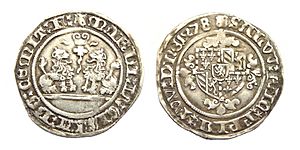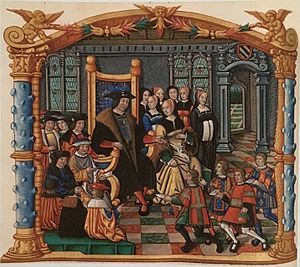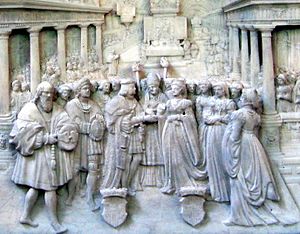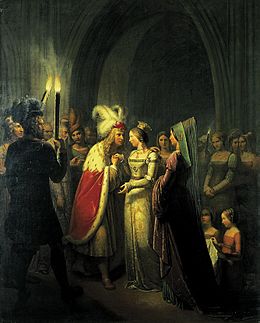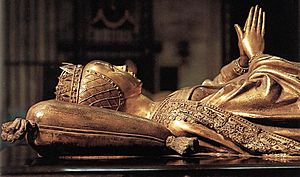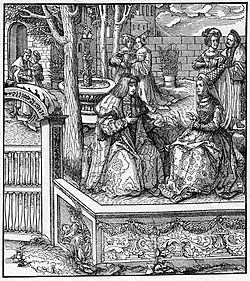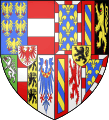Mary of Burgundy facts for kids
Quick facts for kids Mary of Burgundy |
|
|---|---|

Mary of Burgundy wearing a hennin, portrait possibly painted by Michael Pacher, c. 1490.
|
|
| Duchess of Burgundy | |
| Reign | 5 January 1477 – 27 March 1482 |
| Predecessor | Charles I |
| Successor | Philip IV |
| Alongside | Maximilian |
| Born | 13 February 1457 Brussels, Brabant, Burgundian Netherlands |
| Died | 27 March 1482 (aged 25) Wijnendale Castle, Flanders, Burgundian Netherlands |
| Burial | Bruges, Flanders |
| Spouse | |
| Issue | Philip I of Castile Margaret, Duchess of Savoy |
| House | Valois-Burgundy |
| Father | Charles the Bold |
| Mother | Isabella of Bourbon |
| Religion | Roman Catholicism |
Mary of Burgundy (born February 13, 1457 – died March 27, 1482) was a powerful ruler in Europe. She was often called "the Rich" because she inherited vast and wealthy lands. From 1477 until her death at age 25, she ruled over the Burgundian State. This area is now mostly in France and the Low Countries (like modern-day Belgium and the Netherlands).
Mary became Duchess of Burgundy when her father, Charles the Bold, died in battle. She was his only child. To protect her lands from the French king, Louis XI, she married Maximilian of Austria. This marriage was very important. It kept her lands from breaking apart. It also changed who ruled Burgundy, from the Valois family to the Habsburg family. This led to a long-lasting rivalry between France and the Habsburgs.
Contents
Early Life of Mary
Mary of Burgundy was born in Brussels, at the ducal castle of Coudenberg. Her parents were Charles the Bold and Isabella of Bourbon. When she was born, a court writer said there was a clap of thunder from a clear sky.
Her godfather was Louis, the Dauphin of France (the king's son). He was living in Burgundy at the time. He named her after his mother, Marie of Anjou. Not everyone was happy about her birth. Her grandfather, Duke Philip the Good, was disappointed she was a girl. But her grandmother, Isabella of Portugal, was very happy to have a granddaughter. Mary's aunt, Anne, was in charge of her education. Jeanne de Clito was her governess and became a lifelong friend.
Becoming an Heir
When Philip the Good died in 1467, Mary's father, Charles, took control of Burgundy. Since Charles had no living sons, Mary became his heir. This meant she was next in line to inherit his lands.
Her father ruled a very large and rich area. It included the Duchy of Burgundy, the Free County of Burgundy, and most of the Low Countries. Because of this, many princes wanted to marry Mary. The first marriage offer came when she was only five years old. It was from the future King Ferdinand II of Aragon. Later, Charles, Duke of Berry, wanted to marry her. His older brother, King Louis XI of France, was very annoyed by this.
Once King Louis XI had a son, the future King Charles VIII of France, he wanted his son to marry Mary. Charles was thirteen years younger than Mary. Another suitor was Nicholas I, Duke of Lorraine. He was a few years older than Mary. His plan to join his lands with hers ended when he died in battle in 1473.
Mary's Reign
Mary became the ruler of her father's lands after he died in battle on January 5, 1477. King Louis XI of France quickly tried to take over parts of Burgundy. He wanted the Duchy of Burgundy itself, plus regions like Franche-Comté, Picardy, and Artois.
The French king wanted Mary to marry his son, Charles. This would give his family control of the rich Low Countries. Burgundy was worried about France's military power. They sent people to France to talk about a marriage between Mary and the young Dauphin. But the French king demanded too much land, so the talks failed.
The Great Privilege
On February 10, 1477, Mary had to sign an important document called the Great Privilege in Ghent. This happened when she was officially recognized as her father's heir. This agreement gave many rights back to the provinces and towns in the Low Countries. These rights had been taken away by previous dukes who wanted to create a stronger, central government.
For example, the Parliament of Mechelen was closed. The older Parliament of Paris took its place. Mary also had to promise not to declare war, make peace, or raise taxes without the agreement of these provinces and towns. She also had to hire only local people for official jobs.
People disliked the old way of ruling so much that two of her father's main advisors were executed in Ghent. This happened even though Mary tried to save them.
Her Marriage
Mary soon chose her husband from many princes. She picked Archduke Maximilian of Austria. He would later become the Holy Roman Emperor. He also became her co-ruler. Their wedding happened in Ghent on August 19, 1477. Mary was 20 years old, and Maximilian was two years younger.
Mary's marriage to the House of Habsburg started a long conflict between France and the Habsburg family. This struggle lasted for two centuries.
Mary and Maximilian enjoyed dancing, hunting, music, and animals. Mary even tried to teach him ice skating. They read romantic stories together. Mary brought falcons into their bedroom, which they shared instead of living apart. She also had a dog. Mary took care of her children herself and even dined with merchants. She cheered for Maximilian in tournaments, where he was a great jouster. At first, they spoke Latin to each other.
Some reports say that their marriage contract stated Maximilian could not inherit Mary's lands if they had children. This meant that having children would cause problems for Maximilian later. However, one month after their wedding, Mary changed the contract. She said Maximilian would be her heir if they had no children. After her death, the local leaders tried to ignore this change.
Ruling with Maximilian
With Maximilian by her side, Mary's position became stronger. Even though he didn't bring money or an army at first, his skills in military matters helped stabilize her lands. He took charge of the war against France. Many Burgundian military leaders had left to join France. Philip of Cleves, Mary's cousin and childhood friend, became Maximilian's helper.
Mary did not get the Duchy of Burgundy back, but she kept her other lands safe. Even though the Burgundian court was known for being rich, Charles the Bold had lost all his money in his last wars. The Low Countries were wealthy, but the local leaders didn't want to pay taxes. So, money was tight. Mary had to pawn many of her family treasures to pay for their armies. She also had to give in to some of the local leaders' demands for more rights.
In 1478–1479, Maximilian fought against the French. He won a battle at Guinegatte in 1479. Even after winning, he had to stop fighting and send his army home. This was either because the people of the Netherlands didn't want him to become too powerful, or because he ran out of money. Maximilian was also strict in stopping rebellions in the Low Countries. He brought the Hook and Cod wars under control.
Mary remained the main political leader. Her people were suspicious of Maximilian because he was a foreigner and wanted to fight wars. They worried he would try to get the Duchy of Burgundy back and become too strong, like her father. Mary and her daughter Margaret tried to teach him French and Dutch, but he was not a good student. Mary went with Maximilian on his many trips. She helped him communicate with their subjects.
According to a writer from that time, Mary would ask her husband for advice on political matters. But she always managed things her own way. Maximilian was a gentle husband and never went against her wishes. She handled internal affairs and attended meetings where they needed to raise money. Coins from Burgundy showed that Maximilian did not have the same official rank as other royal husbands of that time.
Mary was shown in official pictures as an active and strong ruler, often on horseback with a hawk. She seemed more peaceful than her father. But her position as the rightful ruler was always clear. Maximilian, in his armor, was usually shown behind her. This was different from later portraits where she was shown as less active.
To gain public support, Mary focused on public appearances, especially showing her religious devotion. The winter of 1482 was very cold, and France had stopped salt from coming into the Netherlands. But overall, the political situation in the Netherlands was good. The French attacks had stopped for a while, and there was peace inside the country.
Death and Legacy
In 1482, Mary went on a falcon hunt near Wijnendale Castle. She loved riding horses. While hunting with Maximilian and court knights, her horse tripped. She was thrown into a ditch, and the horse landed on top of her. This broke her back. She died several weeks later, on March 27, from her injuries. She was pregnant at the time. Mary had made a detailed will. She was buried in the Church of Our Lady in Bruges on April 3, 1482.
Maximilian was heartbroken. Mary had first hidden how badly she was hurt to keep him calm. When he continued to grieve uncontrollably, she had to make him leave her room. She needed to talk about important state matters with her nobles. She asked them to remain loyal to Maximilian and their children. Maximilian was not there when she spoke her last words.
Even though the court had no money, they gave her a grand funeral. Maximilian even melted down some of the dishes to pay for it.
Mary's two-year-old daughter, Margaret, was sent to France. She was supposed to marry the Dauphin to please Louis XI and stop him from invading Mary's lands. But it didn't work.
Louis quickly started fighting Maximilian again. He forced Maximilian to agree to the Treaty of Arras of 1482. This treaty gave Franche-Comté and Artois to France for a while. These lands were later returned by the Treaty of Senlis in 1493, which brought peace to the Low Countries. Mary's marriage to the House of Habsburg caused problems for France. It led to conflicts with Spain and the Holy Roman Empire later on.
In 1493, Emperor Frederick III died. Maximilian became the leader of the Empire. He gave control of the Netherlands to his and Mary's son, Philip. By this time, Maximilian had stopped rebellions. He had created a strong monarchy. He made sure that when their son became ruler, Philip only confirmed the rights that existed during the time of Philip the Good.
Historians say that Mary's short rule is often overlooked. She was between her powerful father and her strong husband. Some see her as weak and just a pawn in politics. Others see her as a strong princess who knew what she wanted.
In 2019, Mary was added to the Canon of Netherlands. This means she is seen as a very important figure in Dutch history. A committee said that her marriage to the Habsburg family shaped the Netherlands' place in the world for centuries. They also said that her personality and gentle rule kept the main parts of the Burgundian Netherlands united.
Maximilian often called Mary the "Grand Dame." She stood beside him as a ruler. The people of the Low Countries loved Mary. This helped Maximilian and their children rule during the difficult time after her death.
Family
Mary's son, Philip, took over her lands. His father, Maximilian, was his guardian.
Mary had three children:
- Philip the Handsome (born July 22, 1478 – died September 25, 1506). He became Philip IV of Burgundy after his mother. He also became Philip I of Castile by marrying Joanna of Castile.
- Margaret (born January 10, 1480 – died December 1, 1530). She first married Juan, Prince of Asturias, the son of King Ferdinand II of Aragon and Queen Isabella I of Castile. She later married Philibert II, Duke of Savoy.
- Franz or François (born September 2, 1481 – died December 26, 1481).
Ancestry
| Ancestors of Mary of Burgundy | ||||||||||||||||||||||||||||||||||||||||||||||||||||||||||||||||||||||||||||||||||||||||||||||||||||||||||||||||||||||||||||||||||||||||||||||||||||||||||||||||||||||||||||||||||||||||||||||||||||||||||||||||||||||||||||||||||||||||||||||||||||||||||||||||||||||||||||||||||||||||||||||||||||||||||||||||||||||||||||||||||||||||||||||||||||||||||||||||||||||||||||||||||||||||||||||||||||||||||||||||||||||||||||||||||||||||||||||||||||||||||||||||||||||||||||||||||||||||||||||||||||||||||||||||||||||||||||||||||||||||||||||||||||||||||||||||||||||||||||||||||||||||||||||||||||||||||||||||
|---|---|---|---|---|---|---|---|---|---|---|---|---|---|---|---|---|---|---|---|---|---|---|---|---|---|---|---|---|---|---|---|---|---|---|---|---|---|---|---|---|---|---|---|---|---|---|---|---|---|---|---|---|---|---|---|---|---|---|---|---|---|---|---|---|---|---|---|---|---|---|---|---|---|---|---|---|---|---|---|---|---|---|---|---|---|---|---|---|---|---|---|---|---|---|---|---|---|---|---|---|---|---|---|---|---|---|---|---|---|---|---|---|---|---|---|---|---|---|---|---|---|---|---|---|---|---|---|---|---|---|---|---|---|---|---|---|---|---|---|---|---|---|---|---|---|---|---|---|---|---|---|---|---|---|---|---|---|---|---|---|---|---|---|---|---|---|---|---|---|---|---|---|---|---|---|---|---|---|---|---|---|---|---|---|---|---|---|---|---|---|---|---|---|---|---|---|---|---|---|---|---|---|---|---|---|---|---|---|---|---|---|---|---|---|---|---|---|---|---|---|---|---|---|---|---|---|---|---|---|---|---|---|---|---|---|---|---|---|---|---|---|---|---|---|---|---|---|---|---|---|---|---|---|---|---|---|---|---|---|---|---|---|---|---|---|---|---|---|---|---|---|---|---|---|---|---|---|---|---|---|---|---|---|---|---|---|---|---|---|---|---|---|---|---|---|---|---|---|---|---|---|---|---|---|---|---|---|---|---|---|---|---|---|---|---|---|---|---|---|---|---|---|---|---|---|---|---|---|---|---|---|---|---|---|---|---|---|---|---|---|---|---|---|---|---|---|---|---|---|---|---|---|---|---|---|---|---|---|---|---|---|---|---|---|---|---|---|---|---|---|---|---|---|---|---|---|---|---|---|---|---|---|---|---|---|---|---|---|---|---|---|---|---|---|---|---|---|---|---|---|---|---|---|---|---|---|---|---|---|---|---|---|---|---|---|---|---|---|---|---|---|---|---|---|---|---|---|---|---|---|---|---|---|---|---|---|---|---|---|---|---|---|---|---|---|---|---|---|---|---|---|---|---|---|---|---|---|---|---|---|---|---|---|---|---|---|---|---|---|---|---|---|---|---|---|---|---|---|---|---|---|---|---|---|---|---|---|---|---|---|---|---|---|---|---|---|---|---|---|---|---|---|---|---|---|---|---|---|---|---|---|---|---|---|---|---|---|---|---|---|---|---|---|---|---|---|---|---|---|---|---|---|---|---|---|---|---|---|---|---|---|---|---|---|---|---|---|---|---|---|---|---|---|---|---|---|---|---|---|---|---|---|---|---|---|---|---|---|---|---|---|---|---|---|---|---|---|---|---|---|---|---|---|---|---|---|---|---|---|---|---|---|
|
||||||||||||||||||||||||||||||||||||||||||||||||||||||||||||||||||||||||||||||||||||||||||||||||||||||||||||||||||||||||||||||||||||||||||||||||||||||||||||||||||||||||||||||||||||||||||||||||||||||||||||||||||||||||||||||||||||||||||||||||||||||||||||||||||||||||||||||||||||||||||||||||||||||||||||||||||||||||||||||||||||||||||||||||||||||||||||||||||||||||||||||||||||||||||||||||||||||||||||||||||||||||||||||||||||||||||||||||||||||||||||||||||||||||||||||||||||||||||||||||||||||||||||||||||||||||||||||||||||||||||||||||||||||||||||||||||||||||||||||||||||||||||||||||||||||||||||||||
Titles
 January 5, 1477 – March 27, 1482: Duchess of Burgundy (a title she held, even if some land was lost)
January 5, 1477 – March 27, 1482: Duchess of Burgundy (a title she held, even if some land was lost) January 5, 1477 – March 27, 1482: Duchess of Lothier
January 5, 1477 – March 27, 1482: Duchess of Lothier January 5, 1477 – March 27, 1482: Duchess of Brabant
January 5, 1477 – March 27, 1482: Duchess of Brabant January 5, 1477 – March 27, 1482: Duchess of Limburg
January 5, 1477 – March 27, 1482: Duchess of Limburg January 5, 1477 – March 27, 1482: Duchess of Luxemburg
January 5, 1477 – March 27, 1482: Duchess of Luxemburg January 5, 1477 – March 27, 1482: Duchess of Guelders
January 5, 1477 – March 27, 1482: Duchess of Guelders January 5, 1477 – March 27, 1482: Countess of Flanders
January 5, 1477 – March 27, 1482: Countess of Flanders January 5, 1477 – March 27, 1482: Countess of Artois
January 5, 1477 – March 27, 1482: Countess of Artois January 5, 1477 – March 27, 1482: Countess Palatine of Burgundy
January 5, 1477 – March 27, 1482: Countess Palatine of Burgundy January 5, 1477 – March 27, 1482: Countess of Hainault
January 5, 1477 – March 27, 1482: Countess of Hainault January 5, 1477 – March 27, 1482: Countess of Holland
January 5, 1477 – March 27, 1482: Countess of Holland January 5, 1477 – March 27, 1482: Countess of Zeeland
January 5, 1477 – March 27, 1482: Countess of Zeeland January 5, 1477 – March 27, 1482: Countess of Namur
January 5, 1477 – March 27, 1482: Countess of Namur January 5, 1477 – March 27, 1482: Countess of Zutphen
January 5, 1477 – March 27, 1482: Countess of Zutphen January 5, 1477 – March 27, 1482: Margravine of Antwerp
January 5, 1477 – March 27, 1482: Margravine of Antwerp
See also
 In Spanish: María de Borgoña para niños
In Spanish: María de Borgoña para niños


